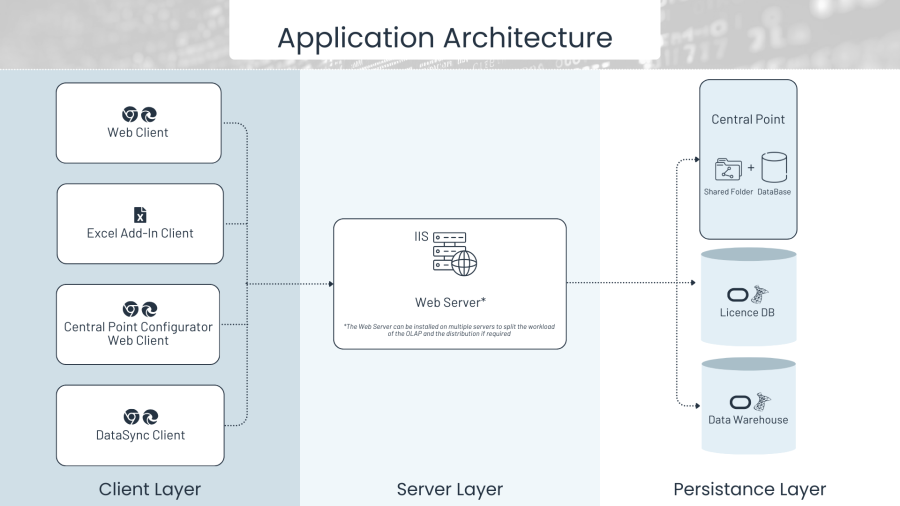Components
The elements listed below are Nectari's components. Since these components are used to retrieve and analyze data, it is important to pay attention to their roles in order to benefit from the most efficient configuration for faster query requests.
The image below illustrates the Nectari architecture and how the components communicate.

Client Layer
Excel Add-in Client
The Excel Add-in application, as the name indicates, is an Add-in for Excel that enables users to build Excel reports using data provided by Nectari. The Excel Add-in requires Microsoft Excel 2016 or later.
Web Client
The Nectari application is the main Business Intelligence application. The application is one responsible for handling requests from web browsers and different clients. The Web Server interface is typically used by end users for inquiry and reporting purposes.
Web Central Point Configurator
This application allows users to modify the Central Point configuration (such as the Description, SMTP, and Databases) after installing Nectari. For example, the configuration may have to be edited if there is a change on the SQL Server hosting the Nectari database or the SMTP server.
DataSync Client
The DataSync application allows users to move data around by picking from a variety of sources and creating jobs that synchronize the content of the data from the source to the chosen destination(s). These jobs can help keep replicated data up-to-date, consolidate data sources into one source, migrate data from one source to another, help extract data into flat file formats, and perform incremental or differential data loads. DataSync is critical for Cloud users and beneficial for on-premise customers as well.
Server Layer
Web Server
Web Server consists of multiple components that are used to extract, transform and load data. It contains components that can query data for end users, allowing them to view and consult this data when creating reports. It also has components that allow users to schedule jobs to synchronize data and offers the possibility to send reports to end users. Some modules of the Nectari application are deployed and hosted on Microsoft IIS. The application can be installed on one or multiple servers depending on the chosen installation scenario. Refer to Installation scenarios to determine which installation type applies to you.
The Nectari application could be installed on any web server, but we strongly recommend having a dedicated server for Nectari. It could also be installed on the DMZ if you want to do your BI analysis from the outside of the organisation/network to Nectari.
Persistence Layer
Central Point
The Nectari Central Point is a repository configured as a Windows Shared Folder (by the installation package) that is accessible in Read and Write mode by the user running the Nectari Web Server.
The Central Point configuration (Nectari) database contains general configuration data such as user access data. It is usually installed on the same server as the Web Server.
License DB
The License Server is a database, called the BI License, that stores the license number that was activated and the concurrent users that can be connected.
A License Server can be used for several Central Points.
Data Warehouse
The OLAP Database, called a Nectari Cube, contains the OLAP Cubes with the extracted data from external data sources used to produce reports.